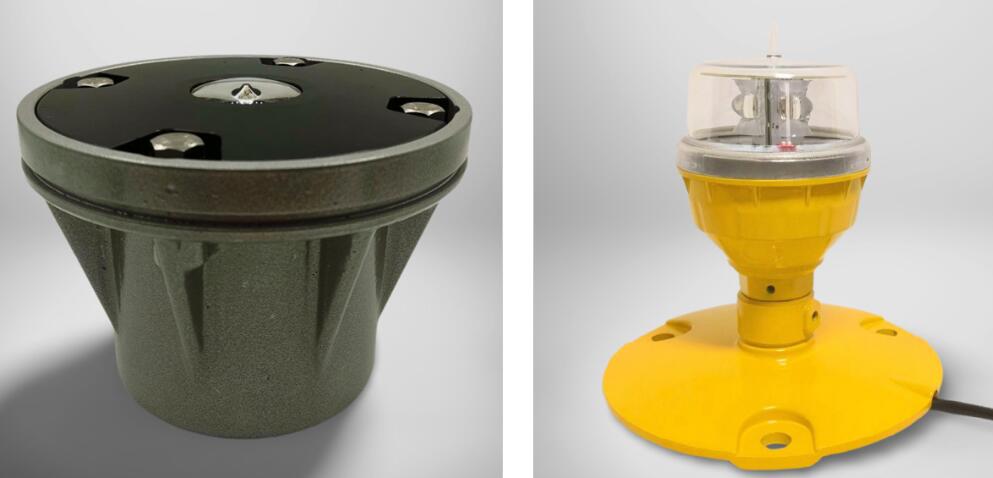Helipad Landing Lights: Essential Illumination for Safe Vertical Flight Operations
Precision lighting systems are critical for safe helicopter operations, especially during nighttime or low-visibility conditions. Helipad landing lights serve as visual guidance systems that ensure pilots can identify landing zones clearly and execute safe approaches. These specialized lighting solutions are designed to withstand harsh environments while providing optimal visibility. This article examines the importance, functionality, and technological advancements of helipad landing lights in modern aviation.
The Importance of Helipad Lighting Systems
Unlike conventional runways, helipads require unique lighting configurations due to the vertical takeoff and landing (VTOL) nature of helicopters. Helipad landing lights must provide:
Clear boundary definition – Marking the edges of the landing area.
Glare-free illumination – Ensuring visibility without blinding pilots.

Weather resistance – Operating reliably in rain, snow, and extreme temperatures.
Regulatory bodies such as the FAA (Federal Aviation Administration) and ICAO (International Civil Aviation Organization) mandate specific lighting standards for helipads to prevent accidents.
| helipad landing lights |
Key Components of Helipad Landing Lights
1. Perimeter Lights
These define the edges of the helipad and are typically:
Omni-directional – Visible from all angles.
Low-intensity (for ground-level helipads) or medium-intensity (for elevated helipads).
2. Floodlights
Provide general illumination for the landing zone, enhancing visibility of obstacles and surface conditions.
3. Approach Path Indicators
Some advanced helipads use:
HAPI (Helicopter Approach Path Indicator) – Guides pilots on the correct descent angle.
LED-based systems – Energy-efficient and long-lasting.
4. Wind Direction Indicators
Often paired with lighting systems, these help pilots assess landing conditions.
Technological Advancements in Helipad Lighting
1. LED Adoption
Modern helipad landing lights increasingly use LEDs due to their:
Low power consumption
| helipad landing light |
Extended lifespan (up to 50,000+ hours)
Instant on/off capability (critical for emergency operations)
2. Solar-Powered Solutions
Remote or off-grid helipads benefit from solar-powered helipad landing lights, which:
Eliminate dependency on electrical grids.
Reduce maintenance needs.
3. Smart Lighting Controls
Some systems now feature:
Automatic brightness adjustment (based on ambient light).
Remote monitoring and diagnostics.
Applications of Helipad Landing Lights
1. Hospital Helipads
Medical evacuation (MEDEVAC) operations require reliable lighting for emergency landings.
2. Offshore Platforms
Oil rigs and marine vessels use helipad landing lights to ensure safe operations in harsh environments.
3. Urban Rooftop Helipads
High-rise buildings in cities require FAA-compliant lighting for corporate and emergency helicopters.
4. Military and Search-and-Rescue (SAR) Operations
Helicopters operating in remote or disaster-stricken areas depend on highly visible landing zones.
Regulatory Compliance and Standards
Helipad landing lights must meet strict guidelines, including:
FAA AC 150/5390-2C (U.S. heliport design standards).
ICAO Annex 14 (International helipad lighting requirements).
EN 12464-2 (European aviation lighting standards).
Compliance ensures uniformity and safety across global aviation operations.
Future Trends in Helipad Lighting
Emerging innovations include:
Wireless control systems for easier adjustments.
Enhanced durability for extreme climates.
Integration with drone landing systems as VTOL aircraft evolve.
Helipad landing lights are indispensable for safe helicopter operations, providing critical visual guidance in all conditions. With advancements in LED technology, solar power, and smart controls, these systems are becoming more efficient and reliable. As urban air mobility and emergency aviation services expand, the demand for high-performance helipad landing lights will continue to grow.
